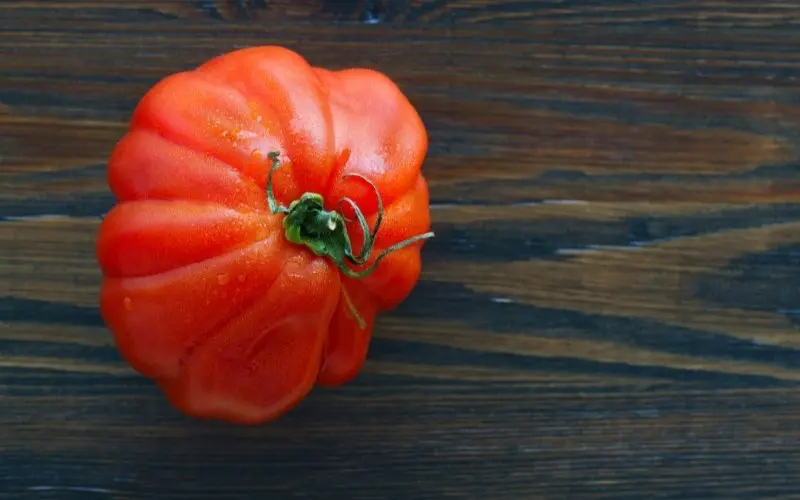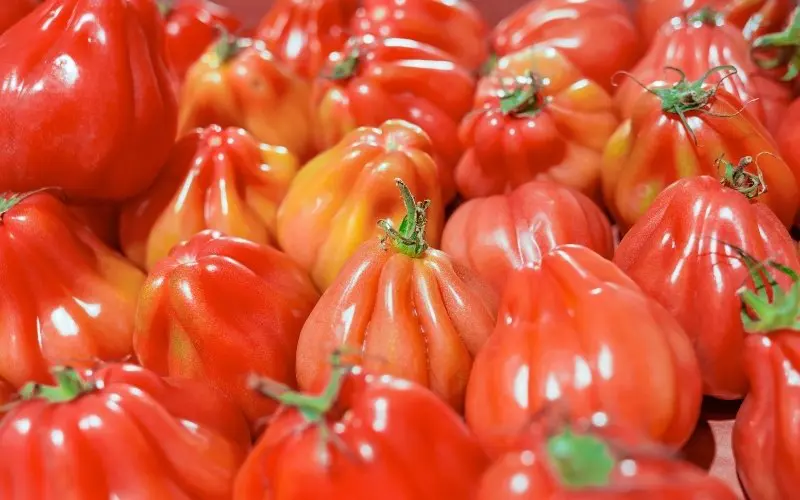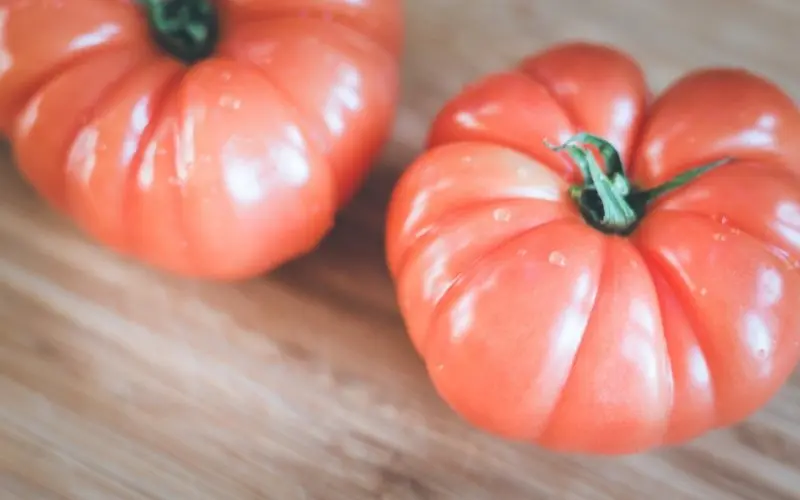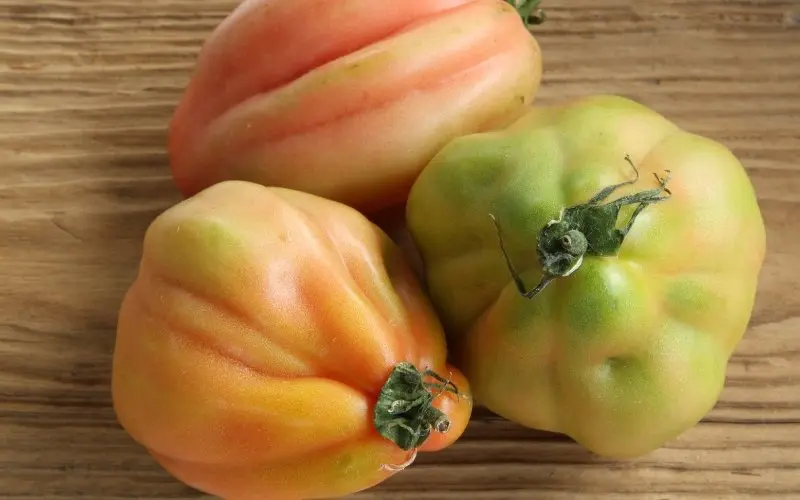Oxheart tomatoes have an exceptional flavor, are heart-shaped and they get up to almost a pound in size! They’re loved for their juicy, meaty texture, and sweet flavor.
These kinds of tomatoes can be a great addition to your vegetable garden, but there are lots of Oxheart varieties to choose from, and how do you properly care for them?
How to Grow Oxheart Tomatoes
To grow Oxheart tomatoes, plant the seeds in good quality soil, in a location that gets 6-8 hours of sunlight per day, and make sure they get watered regularly. To get a huge yield of Oxheart’s, you can start the seeds indoors 6-8 weeks before your last frost date.

Starting Your Tomato Plant Indoors
Oxheart tomatoes can be started indoors around 6-8 weeks before your area’s last frost date. Starting seeds indoors is a great way to get a headstart on the growing season, and give the plants enough time to grow big and provide you with more tomatoes – isn’t that what we’re all after?!
What You’ll Need to Start Seeds Indoors
- Light Source – most windowsills won’t provide enough light, so I usually use a grow light to give the plants all the light they need and make sure they germinate properly.
- Heat Source – you’re usually starting seeds in the winter, and it can get cold inside. Plants usually need around 70-85 degree temperatures to germinate and most homes aren’t that warm, especially in the winter. Heat mats are a great way to make sure you get good germination rates.
- Good Quality Soil – I like this one for a seed starting mix
- Seed Starting Trays – These are hands down the best option for seed starting trays.
- Water – Hose or watering can will work great
- Oxheart Tomato Seeds – depending on the variety you want to grow, but I see great results with seeds from this place.
Starting seeds indoors is pretty easy. You can start this process around 6-8 weeks before your last frost date. My tomatoes came up like crazy this year and I wished I would have waited to around 6 weeks because the frost didn’t go away on that date.
1. Add your potting mix or seed starting soil to a tray, and moisten the soil.
2. Add a few seeds spaced around an inch apart (you can thin them out later).
3. Add a thin layer of soil on top, around 1/4 inch and spray with a spray bottle to moisten.
4. Place seed tray on a heat mat to help with germination. Put a grow light overhead and put it on a timer to be on for 8-10 hours a day. Too much light can cause trouble, but not enough light is often worse.
5. Once seeds start germinating and you see sprouts forming, remove them from the heat or else they might end up leggy and weak. Keep them under the grow lights.
6. Keep the soil moist, checking it every day to make sure it doesn’t dry out.
7. As your plants grow, you’ll want to keep an eye out for tomato suckers, making sure to remove them as they come about.
8. Once your frost date has passed, keep an eye on the 10 day forecase to make sure it really has passed. The dates you find online are estimates, so each year you’ll want to check the weather regularly. Once there is no sign of frost in the forecast, you can transfer them into the ground, following the instructions below.
Planting Seedlings in the Ground
Around 1-2 weeks after the danger of frost has passed, it’s likely warm enough to plant your tomatoes in the ground.
When planning the location for your tomatoes, make sure to choose a location that gets full sun.
Companion planting is another thing to keep in mind when choosing a location, as tomatoes do have quite a few pests and issues to run into. Planting near good companions can help mitigate some of those issues.
Environment & Temperatures
The oxheart tomato is also a very disease-resistant plant, therefore it is not likely to be affected by the usual tomato pests or diseases, like fusarium wilt.
As with most tomatoes, Oxheart tomatoes can be planted outside when soil temperatures reach at least 50 degrees F.
Soil Requirements
Oxheart tomatoes should be planted on rich soils with a pH of 8 (8 being neutral). They need to have lots of phosphorus, nitrogen, and potassium for good growth and development.
If you want to get oxheart tomatoes off to a great start, improve the soil’s quality and texture by digging in lots of organic matter, like compost and manure.
For best results, grow them in rich soil that has a good mixture of compost or manure at least three months before you plan on planting your oxheart garden.
Sunlight
Oxheart tomatoes need at least 8 hours of sunlight in order to grow properly and quickly enough for them to produce a bountiful harvest. Without enough light, plants can get stunted and grow much slower, which may result in a smaller harvest for you.
Oxheart tomatoes should not be planted in areas with too much direct sun; they should be given partial sunlight or light shade. This will prevent the oxheart tomato from having a tough skin and pale, almost white flesh.
Tomato Spacing
Tomatoes need space to grow properly and get enough air circulation to be able to avoid disease and grow a bigger harvest.
Oxheart tomatoes are generally indeterminate varieties, meaning they growing tall and continue to produce fruit throughout the growing season. This is important to understand because you should be good with around 24-36 inches between plants.
When growing more bushy, determinate varieties, you may need more space between them.
Why can’t you just plant a bunch of plants in one area?
- Reduced airflow, which can spread disease and make it easier for pests to duplicate
- Decreased sunlight penetration – their leaves will block the sun from other tomato plants around them and vice versa
- Competing for nutrients – tomatoes are heavy feeders, meaning they need a lot of nutrients to produce fruit. Without these nutrients, you might get smaller tomatoes, or even end up with plants that have a lot of foliage, but no flowers.
Mulching
The weather is crazy these days — we’re seeing some of the hottest summers on record, and this can have a huge impact on your tomato plants.
So how do you mitigate this? Using mulch, such as cedar mulch, can be a great way to keep water from evaporating, as well as reducing the impact on high temperatures on your plants and the soil.
Add 1-2 inches of mulch when you initially plant your tomatoes, and then add more at least once every few months.
Nutrients & Fertilizers
Tomatoes are heavy feeders, so they need quite a bit of nutrients added into the soil. If you are growing in clay soil like I am, you’ll want to add in dolomite lime and some sort of fertilizer.
Even if you are growing in the loamiest loamy soil (yea, I said it), you’ll probably need to add some kind of nutrients at some point throughout the growing season.
- Nitrogen
- Phosphorous
- Potassium
- Calcium
If your soil is lacking in any of these, you’ll run into various problems and end up with a smaller harvest.
Testing your soil is a great way to understand what your soil is high in, and what it might be lacking.
Add tomato fertilizer a few days after planting them in the ground, and then every 2-3 weeks, depending on the instructions you get from the fertilizer manufacturer.

Depth
Planting your seedlings in the ground is pretty straightforward, but there is one tip you might’ve missed.
Cut off all the branches aside from the to 2-3. Then plant that long stem in the ground. While it seems wrong, tomatoes are actually quite interesting in the sense that they will grow roots along that main stem underground.
Planting them this way will give your plant stronger roots that will be able to resist wind and other outside elements better.
Trellis/Stakes/Cages
Tomatoes generally need some kind of support as they grow tall. While cages are popular options, they are better for smaller, determinate tomato varieties. Since Oxhearts are indeterminate, they can get quite tall reaching heights of 6-8 feet, and a 5-foot tomato cage just won’t be large enough.
I really like using this trellis method as you can make it taller to fit your plants, whereas a cage has a static height.
Pollination
Flowers will appear about 10 days after the oxheart tomato plant is large enough to set them, and they should be pollinated at that time.
If your garden doesn’t attract a ton of pollinators (i.e. bees and other flying insects), you can manually pollinate the flowers.
Once flowers are pollinated, the plant will begin producing fruits where the flowers once were.
I like to pick my tomatoes when they are starting to turn from green to their expected color (generally a little pink/red). Waiting too much longer can introduce competition for the fruit, from things like squirrels, deer, rabbits, and the neighbors! 😉
Common Pests
There are a number of worms that impact tomatoes, including:
- Tomato hornworms
- Armyworms
- Loopers
- Cutworms
All of these worms are pretty gross, and not fun to find in the garden. You can avoid finding them on your plants using a B.t. spray like this one.
Aphids are another pest to watch out for. I call them the glitter of the garden, because they come out of nowhere, multiply like crazy, and can be challenging to get rid of…if you don’t know what you’re doing. Neem oil is a great way to help keep aphids out of the garden.
While there are tons of other pests you might find on your plants, these are some of the more common ones.
But worms aren’t the only ones who eat oxhearts, there are plenty of animals that eat tomatoes including:
- Squirrels
- Birds
- Rabbits
- Deer
- Voles
- Raccoons
Types of Oxheart Tomatoes
Most Oxheart varieties are indeterminate tomatoes, meaning they grow taller and keep producing tomatoes throughout the growing season.
Oxheart tomatoes have a lot of different sub-varieties or cultivars. Some produce small fruits, and others grow tomatoes that are over a pound in size.
Pink Oxheart Tomatoes

Pink oxheart tomatoes are deep pink in color, with a meaty texture. They might be smaller than other oxhearts, but they still get to about a pound or so in size. They’re only disease resistant to Verticillium Wilt and Fusarium Wilt 1 & 2.
- Color: Pink
- Fruit size: 16-32 oz
- Days to Maturity:
Willieboy
One of the most popular oxheart types is ‘Willieboy’. It’s a deep pink, oxheart-shaped tomato, and it gets about 1-2 lbs in size.
- Color: Pink
- Fruit size: 1-2 lbs
- Days to Maturity: 75 days
Giant Red Oxheart Tomatoes
Giant red oxhearts have even more flavor than other oxhearts, as well as larger fruit size–so they’re absolutely delicious! It’s rated as moderately resistant to Verticillium Wilt and Fusarium Wilt 1 & 2.
- Color: Dark red
- Fruit size: 1-2 pounds
- Days to Maturity: 75 days
Striped Oxheart
A striped oxheart tomato is one that has multiple colors in it, with a deep pink skin. They’re meatier and less acidic than other oxhearts, making them extra juicy and flavorful.
- Color: Red-yellow bicolored
- Fruit size: 4-5 oz
- Days to Maturity: 60 days
Cuore Di Bue Heirloom

Cuore di Bue was an oxheart tomato used by the Italian immigrants of the early 1900s, and it gets up to about a pound in size. It has a delicious flavor, but some say they’re slightly less juicy than other oxhearts.
- Color: Orange-Red
- Fruit size: 16oz
- Days to Maturity: 85 days
Anna Russian
- Color: Pink-red
- Fruit size: 24-32 oz
- Days to Maturity: 70 days
Anna Russian tomatoes are oxheart-shaped and come in a deep red/pink color. They’re meaty and sweet, but they can also get huge in size–which can make them less resistant to cracking or disease.
Anna was grown by Russian Immigrants in the early 1900s, so they named it after their favorite Tsarina at the time, Anna of Austro-Hungary.
Giant Oxheart
- Color: Pink-red
- Fruit size: 1-2 lbs
- Days to Maturity: 89 days
Giant Oxheart tomatoes are big producers, not just in size, but in number of tomatoes you’ll get per season. It has thick walls and a great sweet flavor.
You can even grow purple oxheart tomatoes!
Japanese Oxheart
- Color: Pink-red
- Fruit size: 1-2 lbs
- Days to Maturity: 87 days
Japanese oxheart tomatoes have a rich, meaty flesh you’ll love. These are great if you want the perfect tomato for a sandwich.
How to Use Oxheart Tomatoes in the Kitchen
Oxhearts are great for fresh eating right off the vine, but there are a lot of other options for using them.
Tomato sandwich – never had one? You’re in for a treat. Oxhearts are considered to be great slicing tomatoes. Grab some sourdough bread, slice up your Oxheart and place it on the bread. Add other ingredients like cheese, mayo, mustard, or whatever condiments you enjoy and get ready for a great taste sandwich!
Add to Salads – This tomato variety is a great addition to salads as well. You can make sundried tomatoes, or add them on top for a fresh flavor.
Stuffed Tomatoes – Cut open, add your favorite filling and bake for around 20-40 minutes. The size of these tomatoes and their meaty texture makes them great for making stuffed tomatoes in the oven.
The History of Oxheart Tomatoes
Oxheart tomatoes are said to have come from Russia or Siberia. They were first known as Troistra and were introduced into America in the 1920s.
While they have a long past, now they fill gardens around the world with their delicious flavor and awesome colors.



Would they be the ones that are called. Russian bull heart ?